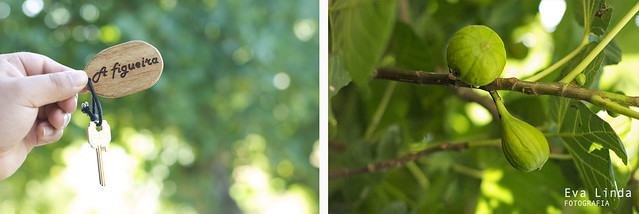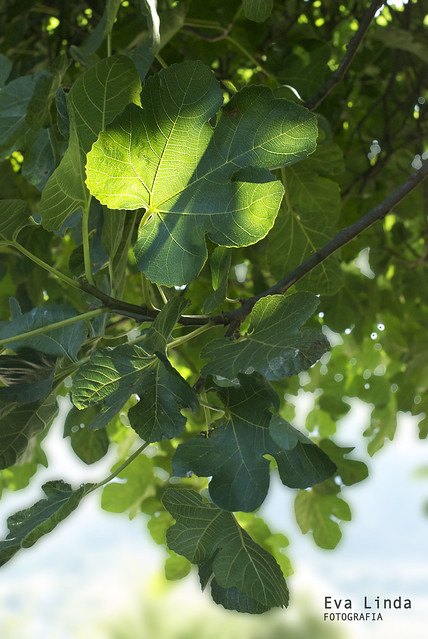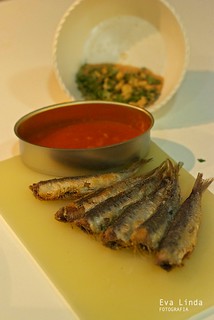Este mes vengo "vestida de dulce" por que la ocasión se lo merecía. Teniendo esos higos de delicado sabor era tentador preparar un postre. Pero en mi casa no somos de comer mucho dulce, así que debía ser algo que no fuera empalagoso.
En esta receta los higos aportan la parte dulzona; el queso fresco mascarpone le da frescura y unas notas ácidas; y la galleta, el toque crujiente y untuoso.
En este caso, yo he preparado la receta "de cabo a rabo", es decir, las galletas, los higos caramelizados y la crema de mascarpone. Pero si queréis hacer una versión más rápida y simple, podéis utilizar alguna galleta que os guste. Creo que podrías combinar bien con alguna que tenga almendras o un toque de canela.
Este es un plato en el que podemos tener preparadas las galletas y la crema de mascarpone, pero es recomendable preparar a último minuto los higos, y servir tíbio.
¿Qué vamos a necesitar si queremos preparar unas 8 porciones?
Para las galletas sablé:
150g de mantequilla
90g de azúcar lustre
1 huevo pequeño batido
250g de harina
Preparación de las galletas:
1. Mezclamos la mantequilla con el azúcar y batimos bien hasta que haya blanqueado un poco.
2. Añadimos el huevo y mezclamos de nuevo.
3. Tamizamos la harina y la incorporamos mezclando a la mezcla anterior, hasta obtener una masa uniforme.
4. La ponemos entre papel transparente y la aplanamos con un rodillo. O rellenamos la manga pastelera con la masa (debe quedar blandita).
5. Dejamos reposar la masa en la nevera durante unos 20 minutos.
6. Si hemos preparado una placa entre film transparente cortamos las galletas con un cortamoldes o con un cuchillo de hoja fina (no de sierra). Pero si vamos a usar la manga pastelera, damos la forma deseada a la galleta encima de la placa de hornear.
En este caso yo usé una boquilla cornet plana 20x3 e hice dos hileras juntas.
7. Horneamos a 170ºC durante unos 20 minutos o hasta que estén doradas.
Para la crema de mascarpone:
250g de mascarpone
100ml de nata para montar
40g de azúcar
una pizca de canela molida (opcional)
Preparación de la crema de mascarpone:
1. Bate la nata de montar con el azúcar y la canela sólo un poco sin que llegue a montar del todo.
2. Añade el queso mascarpone y sigue batiendo hasta obtener una pasta homogénea.
3. Conservala refrigerada mientras no vamos a servir.
Para los higos caramelizados:
100g de azúcar
1 trozito de canela en rama (opcional)
8 higos frescos
zumo de 1 limón
agua
Preparación de los higos caramelizados:
1. Lava y corta los higos por la mitad. Procura dejar un poco de rabo para que sean más bonitos. ¡Cuida la estética del plato!
2. En un cazo pon a cocer el azúcar con la canela y un chorrito de agua. Cuándo empieza a caramelizar añade los higos y el zumo del limón.
3. Cocina a fuego lento y ve girando los higos para que se caramelicen bien.
Servir:
1. Con la ayuda de dos cucharas forma "querelles" (bolitas alargadas). Es decir pasa la masa de una cuchara a la otra formando una bolita alargada de crema de queso.
2. Sirve dos "quenelles" encima de cada galleta. Y cubre de nuevo con otra galleta.
3. Encima coloca dos mitades de higos y decora con un poco del caramelo de higos que habrá quedado en el cazo.
4. ¿Y a qué estás esperando? Disfrútalo.
_________________________________________________________________
_________________________________________________________________
This month I come "dressed in sugar" because the occasion deserves it. The delicate flavor of figs lends itself to creating amazing desserts, but at home we don't really have a sweet tooth so I had to cook something that wouldn't be too sickly.
In this recipe, figs bring in the sweet bit; the fresh mascarpone cheese contributes with freshness and a little bit of an acidic flavor; and the biscuits gives it the crunchy and oily element.
I have prepared this recipe from beginning to end; which is to say, I have done the biscuits, the caramelized figs and the mascarpone cream. However, if you'd like a quicker version, you could use other biscuits you like, especially if they have almonds and a little touch of cinnamon.
For this dessert, you can prepare the biscuits and cream cheese ahead of time, but you should prepare the figs just before serving so they're still warm.
What ingredients will we need to prepare 8 portions?
Biscuits
150g butter
90g icing sugar
1 small egg, whisked
250g flour
Preparation
1. Mix the butter with the sugar and beat until white.
2. Add the egg and mix again.
3. Sieve the flour and gently add it to the mix, until well combined.
4. Place the mix between two sheets of baking paper and flatten it with a roller. Or fill a pastry bag with the dough (it should be squishy).
5. Leave the dough to rest in the fridge for 20 minutes.
6. If you placed the dough in baking paper, slice the biscuits with a cookie cutter (or something to that effect). If you used the pastry bag, shape your biscuits with pleasure :). Place biscuit dough on a baking tray.
7. Bake at 170ºC for 20 minutes or until golden.
Mascarpone cream
250g mascarpone
100ml whipping cream
40g sugar
ground cinnamon (optional)
Preparation
1. Beat the cream with the sugar and cinnamon, just a little bit.
2. Add the mascarpone cheese and keep beating until you get an homogeneous thick cream.
3. Keep it in the fridge until serving.
Caramelized figs
100g sugar
1 cinnamon stick (optional)
8 fresh figs
juice of 1 lemon
water
Preparation
1. Wash and cut the figs in half. Try to leave a little bit of the tale so they look nicer. Keep an eye on the aesthetics of your dessert!
2. In a saucepan, cook the sugar with the water (and cinnamon) until it begins to caramelize; add the figs and lemon juice.
3. Cook in low heat and turn the figs so they caramelize properly.
Serving
1. Using two spoons, make a large ball of cream cheese.
2. Place two cream cheese balls on top of a biscuit, and place another biscuit on top.
3. On top of this, place two halves of a fig and embellish with the caramel from the figs.
4. And now… Enjoy!






















